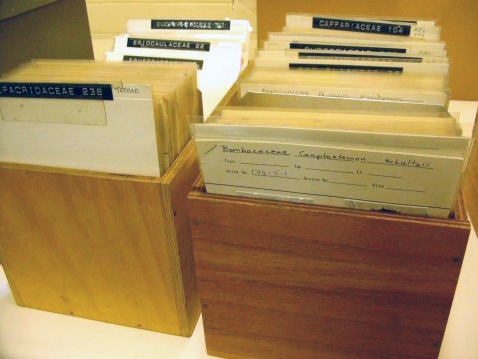
The APSA reference collection cabinets housing over 15,000 reference sample vials and slides.

Over 4000 pollen and spore taxa have been cataloged, to form an easy-to-handle card reference collection in the laboratory.
In Australia existing collections of pollen and spore types are fragmented and there has been no attempt to co-ordinate or integrate this information. The Natural History section of the Department of Archaeology and Natural History (ANH), Australia National University, holds the largest collection of modern pollen of southeast Asia-Australia in the world, amounting to over 15000 taxa from Australia, Southeast Asia and the Pacific (ANH Pollen Collection 1960-2007).
This collection has developed through a long term research effort in palaeoclimatology, palaeoecology, archaeology and more recently in aerobiology, and continues to support high-profile research outcomes in the Department's research areas. Smaller collections are held at other institutions including Monash University (Monash Pollen Database), University of Newcastle (Newcastle Pollen Collection Shimeld et al. 2000), University of Sydney (Woolcock Institute of Medical Research, 200 species with allergenic properties, Hjelmroos et al. 1999), the Australian Nuclear Science and Technology Organisation, University of Melbourne, University of Tasmania and Southern Cross University.
These collections have developed from specific local institution research needs. For example the ANH Pollen Collection laboratory also hosts the Indo-Pacific Pollen Site Database which collects available data on vegetation change derived from identification of pollen from fossil setting for the area from tropical India, through Australia and to Easter Island. The information is available spatially and the results can be searched chronologically. This database is a keystone of global programs for testing palaeoclimate models, vegetation change, landscape change and human effects on catchments and fluvial systems. In addition, the ANH initiative has made us a regional centre of the Global Pollen Database which is located in Boulder, Colorado, and has already been used in several major global vegetation-climate modeling projects (Prentice 2001). This information will be integrated into the Atlas to allow queries on the spatial and temporal occurrence of key pollen and spore taxa. A common characteristic of all collections is that there exists a large and rapidly growing volume of data associated with the pollen and spore species represented, which risks being lost (due to limited funding) or being duplicated (due to disparate locations and/or discipline boundaries).
In order to establish a working database that can function in a multi-disciplinary environment, with the potential to break down inter-disciplinary boundaries, the Australasian Pollen and Spore Atlas will not only have the attribute of enabling continued development of collections of pollen and spore data at independent institutions, but provide a federated platform for development of an interactive and unified database available to the wider professional and novice community.
Hjelmroos, M., et al. (1999)
Airborne Allergens: Interactive identification of allergenic pollen and fungal spores. CD and User Guide. Institute of Respiratory Medicine Limited, Australia.
Shimeld, P., et al. (2000)
Pollen image management: the Newcastle digital collection initiative, Quaternary Australasia, 18, 13-15.
Prentice, I.C. (2001)
Last Glacial Maximum and mid-Holocene vegetation: data and models. Nova Acta Leopold, NF 88, 61-70.
Punt, W., et. al. (2007)
Glossary of pollen and spore terminology. Review of Palaeobotany and Palynology, 143:1–81.